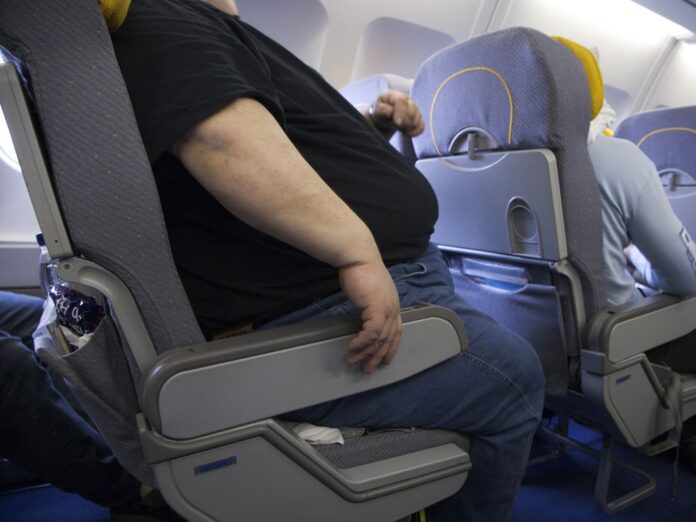By Jeph Ajobaju, Chief Copy Editor
Long before Covid, people had been getting heavier, now there is a surge in air travel post-pandemic, and airlines may demand flyers get weighed or provide their weight before boarding.
The idea is being floated in the United States, from where it will inevitably go round to the ends of the earth, including regions where obesity or fatness is part of cultural fabric, viewed with pride or with a shrug.
The initiative is probably borrowed from Pakistan International Airlines (PIA) which instructed “obese” employees of its cabin crew to lose weight in the first six months of 2019 or risk losing their jobs.
ARY News published on January 2, 2019 a memo issued by PIA which said the management decided to “gradually reduce waiver of 30 lbs. excess weight to zero lbs. in upcoming months for the cabin crew.
“Any crew found above 30 lbs. from the desired weight after 31st Jan, 2019, will be grounded and referred to Air Crew Medical Center for medical evaluation & treatment until weight is reduced up to desired standard/BMI.
“Henceforth, weight check of all the cabin crew will be carried out at their base stations respectively and comprehensive data will be maintained for perusal of management.”
Allowable weight limit
The new plan, outlined in an advisory by the US Federal Aviation Administration (FAA), seeks to provide new data on average passenger weights as the current numbers reportedly don’t reflect today’s sky-high obesity rates in the US.
In turn, this would help ensure aircraft, especially the small ones, don’t exceed their allowable weight limit, View From the Wing reported, quoted by The New York Post.
The FAA wants to gauge how much fatter Americans have got, to prevent things from coming apart when planes take to the skies.
The new mandates, reviewed by airline industry publication AirInsight Group, require airlines to take surveys to establish “standard average passenger weights” for crew members, baggage and passengers via random selection.
Once they have chosen a traveller, a carrier may “determine the actual weight of passengers” by having them step “on a scale before boarding the aircraft,” per the guidelines transcribed by AirInsight.
If that is not an option, they are urged to ask each passenger their weight, while making sure to add 10 pounds to account for clothing.
They even have a contingency plan for when operators suspect flyers are miscalculating their heft. In that case, crew members should “make a reasonable estimate about the passenger’s actual weight and add 10 pounds,” says the document.
Naturally, weighing people like luggage may seem a bit awkward, which is why the FAA also provided guidelines on conducting the procedure in a way that protects passenger privacy.
They stipulate that “the scale readout should remain hidden from public view” while “an operator should ensure that any passenger weight data collected remains confidential.” Chalk one up for bedside manner.
However, travellers have the option of declining “to participate in any passenger or bag weight survey,” per the guidelines.
“The FAA issued an Advisory Circular in May 2019 that stressed the importance that airline weight and balance programs accurately reflect current passenger weights,” the FAA said in a statement to The New York Post.
“Operators are evaluating their programs to comply with this guidance. While weighing customers at the gate is an option, most operators will likely rely on updated methods for estimating passenger weights.”
To update guidelines on “standard passenger weight,” airlines have to up the weight of an average adult male passenger and carry-on bag to 190 pounds in the summer and 195 pounds in the winter, an increase of 20 pounds from the current guidelines.
Female passengers and carry-on bags will increase from 145 pounds to 179 pounds in summer, and 150 pounds to 184 pounds in winter.
Setting average standard passenger weights
The Independent (UK) adds that aircraft are required to ensure a safe weight before taking off and factor in averages for passengers and crew, as well as cargo and fuel.
According to the circular advisory from the FAA, airlines could be asked to start updating average airline passenger weight to account for increases in the average weight of American adults.
The Independent quoted airline blog View from the Wing as writing that “the FAA realises that passenger weight can vary by route and airlines may want to document this difference.
“Standard weights may not be appropriate for smaller planes, with smaller sample size and greater likelihood of variance from average.”
The weighing of passengers, according to the FAA, would set “standard average passenger weights” for crew members, baggage and passengers every 36 months.
AirInsight, also reporting on the FAA advisory, added that surveying would be random and voluntary, with passengers able to refuse.
“Regardless of the sampling method used, an operator has the option of surveying each passenger and bag aboard the aircraft and should give a passenger the right to decline to participate in any passenger or weight survey,” the FFA advisory wrote.
“If a passenger declines to participate, the operator should select the next passenger based on the operator’s random selection method rather than select the next passenger in a line.”
Average weights for male adults will be increased to 190 lbs in the summer and 195 lbs in the winter – up 12 per cent from 170 lbs and 175 lbs, according to analysis by AirInsight.
Increase in obesity
A further increase is also coming for female passengers, from 145 lbs to 179 lbs in the summer and from 150 lbs to 184 lbs in the winter.
It is unclear when weighing airline passengers could begin, although the FAA circular was first issued on May 9, 2019, before it caught the attention of AirInsight and View from the Wing.
In a statement to The Independent, the FAA said it “issued an Advisory Circular in May 2019 that stressed the importance that airline weight and balance programs accurately reflect current passenger weights.
“Operators are evaluating their programs to comply with this guidance. While weighing customers at the gate is an option, most operators will likely rely on updated methods for estimating passenger weights.”
According to the US National Center for Health Statistics, 42 per cent of adults above 20 years of age are obese – increasing from 30 per cent in 2000.
Airline travel in the pandemic caused a collapse in passengers numbers and carbon emissions, with Carbon Monitor reporting a 48 per cent drop in emissions on figures from 2019.
The industry is beginning to restart, especially in the US.














